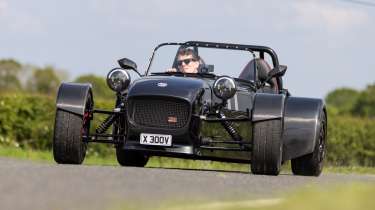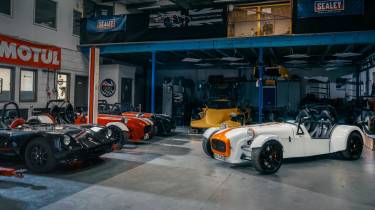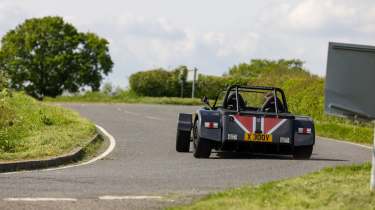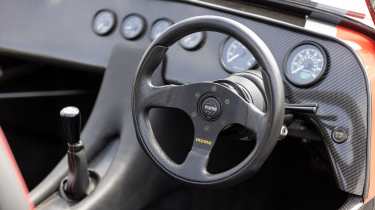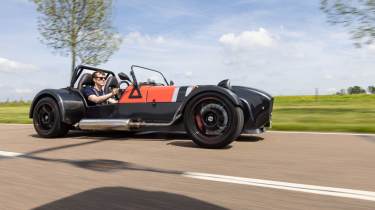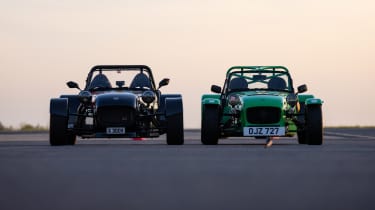GBS Zero review – a convincing Caterham alternative?
GBS is a small but mighty manufacturer that majors on detailed in-house engineering for its Zero.
It might look like a Caterham from a distance, but it isn’t. It’s a GBS, which stands for Great British Sports Cars. The Ollerton factory in which it’s built sits amid pretty, rolling countryside, and some nice roads, in Nottinghamshire. We paid a visit to learn more about the company, and to sample its Seven-style sports car, the GBS Zero, on both road and track.
‘It’s about taking the Lotus Seven concept and bringing it right up to date,’ says director Richard Hall. The Zero has double-wishbone independent suspension all-round and is longer, wider and roomier than a traditional Seven. It still has a steel tubular spaceframe but with stressed aluminium sections making it akin to a semi-monocoque. Hall says it’s more than two-thirds stiffer than an equivalent Caterham.
The Zero is now in its ‘Gen 2’ evolution. Its shape is instantly recognisable as a Seven, albeit a little more square-cut and broad-shouldered. Drag-fighting aerodynamics are incorporated into its design: there’s a fully flat floor with a generous diffuser that starts just behind the seats, a splitter moulded into the nose and aerodynamic surfaces for the front cycle wings, refined in the wind tunnel at MIRA.
Customers can choose more traditionally shaped wings if they prefer. ‘People say the Seven is like a brick, but you can knock the corners off a brick,’ Hall smiles.
Various engines have been placed in the Zero over the years – many have the 2-litre Ford Zetec – but today GBS offers the 2.5-litre Ford Duratec as its primary powerplant, with a five-speed Mazda gearbox. It also offers an option catering for Mazda MX-5 engines, a popular choice particularly for kit-build cars.
Some wackier choices have also found their way into Zeros – bike engines, rotaries, even a 330bhp Honda S2000 engine in a race-car build. But the Duratec is the main option for factory-build cars, modified by GBS with its own throttle bodies, a 3.7kg lighter flywheel and a baffled sump, among other alterations, and governed by a Life Racing ECU. It develops 210bhp, though a 256bhp upgrade is offered too, with forged rods, pistons and cams.
> The new Caterham Seven CSR Twenty is an £80k road-ready Seven
The majority of Zeros produced have been kits, but GBS is concentrating more and more on fully factory-built, turn-key cars. Its most natural competitor is Caterham, and while it doesn’t intend to produce cars in the same numbers, it is concentrating on making inroads into a modest but sustainable percentage of the Seven’s market share. Its main UK dealer, Central GB in Nottingham, now sells GBS cars alongside Lotus and Morgan operations.
The most basic Zero kit option, with the bare minimum of components for an MX-5 donor car, costs only £4500, and there is a sliding scale upwards from that, topping out at around £30,000 for an all-in, no-donor-car-required Duratec-engined kit. The price for a factory-built Duratec car is £41,860.
GBS’s 14 full-time staff manufacture a remarkable amount of the Zero’s components in-house: its own four-piston brakes, uprights, hubs, pulleys, seats, windscreens, sump, throttle bodies, optional carbonfibre wheels (a recent development), the entire exhaust system including the catalytic converters… Very little is outsourced. They’re attractive components too: in situ on the car or individually as objects, parts like the front uprights and hubs, the throttle bodies and the brake units really do look great. They’re offered in custom-anodised colours to suit customers’ individual specs, too.
The company’s own dampers offer 12 clicks of adjustment, and Hall is proud of their performance, particularly the precision of their initial reaction to an input: ‘The most important thing,’ he stresses. Currently, the Zero is offered with proprietary Gaz dampers as standard, with GBS’s adjustable dampers a £528 option. It’s looking at creating its own non-adjustable units, too, as a more affordable option for customers.
GBS has also produced dampers for stock car championships, historic racing cars and existing road cars such as the Lotus Elise under the ATR brand. The engineering side of the business makes a variety of components for various clients. ‘Diversifying into different projects also feeds into our production and development side, making the cars better,’ Hall adds.
As does motorsport. Several customers compete in their Zeros, and a track/race version is available from the factory, with a sequential gearbox and a choice of reassuringly strong MSUK or FIA-spec roll-cages.
So, what does the regular, 2.5-litre petrol-powered Zero feel like to drive? Heading out onto the lanes, it immediately feels like a wide car compared with other Seven-style sports cars. A muscular one too, with weighty steering and a deep soundtrack from its torque-rich 2.5-litre engine. With a kerb weight of just under 600kg, the Duratec’s 196lb ft is so easily drawn upon that you’re rarely in first and second gear for very long, and the Zero can pull out of villages in fifth gear and accelerate up to the national speed limit without breaking into a sweat.
Ride quality is pliant with the adjustable dampers on close to their softest setting, and the handling solid: the Zero is a consistent car, stable under braking and with strong traction – a quality aided by the independent rear suspension. An open diff is standard, and there are two limited-slip options: a Quaife ATB unit, or a plated diff as fitted here.
On a hot, sunny day and wearing a fresh set of Yokohama A052 tyres (AD08s are standard) it needs provocation to breach its limits, but when it does so it’s consistent and controllable, and doesn’t spring any nasty surprises. And at all speeds, fast and slow, there’s the particular magic that comes with driving a minimalist, roofless, doorless car on a summer’s day.
Hall says that road compliance and manners have always been equally important attributes for the Zero, both in terms of chassis and powertrain. ‘We’ve spent as much time tuning the response on a partial throttle input for driving at lower road speeds as we have on getting top-end performance,’ he explains.
On a circuit, its balance is similarly stable and predictable. Initially, there’s a little too much body movement on its road-friendly damper settings, but it’s a quick, straightforward process to increase the stiffness, and the Zero morphs into a calmer, more stable platform for lapping. As on the road, the most impressive attribute is consistent behaviour in each corner, on each lap.
Fit and finish are smart, with optional carbonfibre trim for the dashboard (with Smiths instruments, soon to be replaced with GBS’s own design on future cars) and centre console. The windscreen is heated as an option – ‘We did that for Norway,’ Hall explains – and heated seats are available in place of a conventional heater.
Another luxurious appointment in the GBS is self-cancelling indicators, something not seen on the Caterham Seven since the all-round double-wishbone CSR model. It’s a welcome addition, given the number of times I’ve accidentally driven a Seven down the road with one indicator coquettishly winking at traffic all around, not hearing the accompanying beeping sound amid the road and wind noise.
Our Bedford Autodrome session also provides an opportunity for a back-to-back with our Caterham Seven long-termer. Lined up side by side, it’s immediately clear just how much bigger the GBS is, and how much longer its suspension arms are. Sheer roominess is one of the Zero’s USPs; a six-foot-plus driver fits without difficulty.
GBS also offers a 40mm-wider GT chassis option, but the standard chassis is likely wide enough for most people. There’s enough space in the footwell to drive wearing boots or wide trainers, and heel-and-toeing is much easier than in the Caterham. Out of the way above your right knee, and your passenger’s left, is an extra diagonal cross-brace, something Hall says contributes significantly to chassis stiffness.
The Zero’s main rear-view mirror is at dash level and works well, while the exterior mirrors are mounted to the windscreen frame rather than the sidescreens, so they don’t disappear when you take the doors off, as per the Seven. GBS is trialling some different mirrors, those on this particular car being from a motorcycle – their odd shape impacts the ultimate field of vision but a different design is being fitted soon.
The Zero’s steering is both weightier and slower than the Caterham’s – although a quicker rack is available as an option – but its turning circle is usefully smaller at parking speeds. On both road and track, the Caterham feels edgier at the limit than the GBS, with a more rapid transfer between under- and oversteer.
There were still clicks available to stiffen the GBS’s dampers further, while our Caterham Seven evo25’s own adjustable dampers were set close to their firmest setting. So the Zero’s handling could have been made edgier and vice versa for the Caterham, though you sense the GBS’s broader footprint and larger dimensions ultimately make it a less pointy car.
I must say, I love the Caterham’s eager edginess, and even its more cramped, like-a-glove cockpit, though I do wish there was more space in the footwell. I also find its smaller dimensions and aesthetic more beguiling than the larger, more brawny GBS. I have a particular bond with the evo25 car, though. I feel like I know it inside out, having covered so many miles on road and track and made so many memories with it over many months.
That’s not to say that you wouldn’t build a similar bond with the GBS Zero over time, and it certainly has advantages in terms of practicality and useability as well as thoughtful depth to its engineering and design, and well-resolved dynamics. While the Caterham would still be my choice in terms of ultimate thrills, the Zero can still provide a special kind of sports car magic.
This story was first featured in evo issue 325
